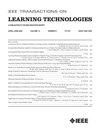翻转式远程实验室:使用同伴评估工具学习 3D 建模
IF 2.9
3区 教育学
Q2 COMPUTER SCIENCE, INTERDISCIPLINARY APPLICATIONS
引用次数: 0
摘要
本文介绍了一种新颖的远程实验教学方法,专门用于使用 Blender 软件进行三维建模教学。该实验室使用虚拟机为学生提供开展课程活动所需的计算能力以及正确版本的软件。翻转远程实验室方法结合了翻转课堂和同伴评估的元素,适合面授、完全在线或混合式课堂。在每两次讲座之前,学生们都会通过一组简明教程,模仿教师的演示开始练习。完成指定任务后,学生除了要对自己的建模进行自我评估外,还要对同伴创建的两个模型进行评估。由三个问题组成的评分标准为评估过程提供了便利,并允许对每个答复提供反馈。在随后的讲座中,学生们与教师一起解决建模过程中遇到的难题,并探索软件使用的高级方面,而在传统环境下,由于时间限制,这些问题无法解决。对翻转远程实验室结果的分析表明,学生在互评活动中的回答与提出的问题相关。此外,实现模型的学生在自我评估中表现出的严谨程度与审查他们作品的同学不相上下。虽然学生们对实验活动表示高度赞赏,但一个值得关注的问题是,实验活动的工作 量非常大。增加分配给完成任务的时间有助于减轻工作量的影响。文章最后介绍了从实施翻转式远程实验室方法中获得的启示。本文章由计算机程序翻译,如有差异,请以英文原文为准。
A Flipped Remote Lab: Using a Peer-Assessment Tool for Learning 3-D Modeling
This article introduces a novel approach to remote laboratory instruction, specifically designed for teaching three-dimensional modeling using Blender software. The lab uses virtual machines to provide students with the necessary computational power to carry out the course activities, along with the correct version of the software. The flipped remote lab approach combines the elements of flipped classroom and peer assessment, making it suitable for face-to-face, totally online, or hybrid classes. Prior to each of the two lectures, students begin to practice by replicating the instructor's demonstrations in a set of concise tutorials. Upon completion of the assigned tasks, students carry out self-assessments of their own modeling, in addition to assessing two models created by their peers. A rubric comprising three questions facilitates the assessment process and allows providing feedback on each response. During the subsequent lecture, students work together with the instructor to address challenges encountered in their modeling, exploring also the advanced aspects of software usage that time constraints preclude in a traditional setting. The analysis of the flipped remote lab results reveals that student responses in peer-assessment activities are relevant to the posed questions. Moreover, the students who realized the models demonstrated a comparable level of rigor in self-assessment as their mates who reviewed their works. While students express a high degree of appreciation for the laboratory activities, a notable concern is the highlighted heavy workload. Increasing the allocated time for task completion can help mitigate the workload impact. The article concludes with insights gained from the implementation of the flipped remote lab approach.
求助全文
通过发布文献求助,成功后即可免费获取论文全文。
去求助
来源期刊

IEEE Transactions on Learning Technologies
COMPUTER SCIENCE, INTERDISCIPLINARY APPLICATIONS-
CiteScore
7.50
自引率
5.40%
发文量
82
审稿时长
>12 weeks
期刊介绍:
The IEEE Transactions on Learning Technologies covers all advances in learning technologies and their applications, including but not limited to the following topics: innovative online learning systems; intelligent tutors; educational games; simulation systems for education and training; collaborative learning tools; learning with mobile devices; wearable devices and interfaces for learning; personalized and adaptive learning systems; tools for formative and summative assessment; tools for learning analytics and educational data mining; ontologies for learning systems; standards and web services that support learning; authoring tools for learning materials; computer support for peer tutoring; learning via computer-mediated inquiry, field, and lab work; social learning techniques; social networks and infrastructures for learning and knowledge sharing; and creation and management of learning objects.
 求助内容:
求助内容: 应助结果提醒方式:
应助结果提醒方式:


